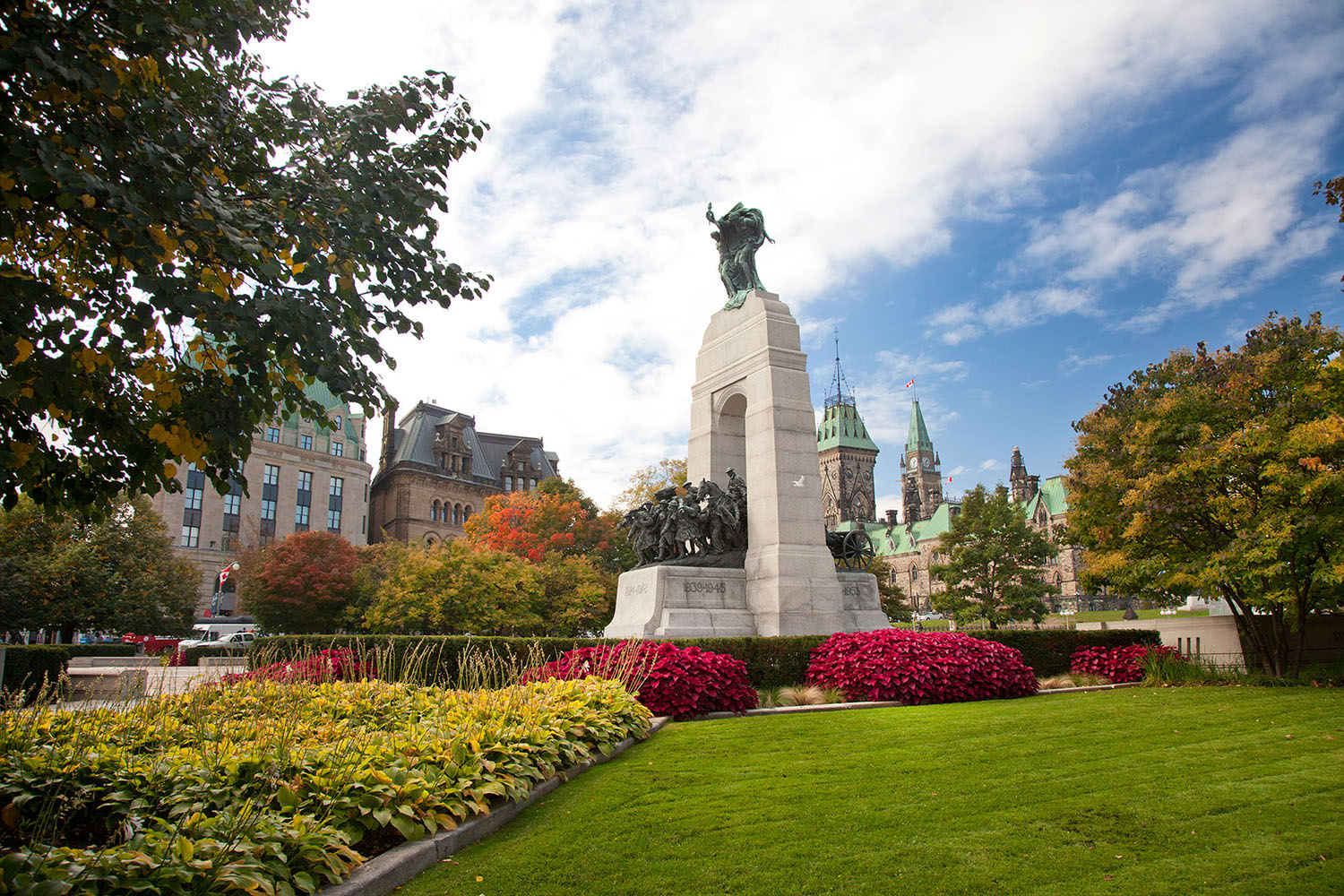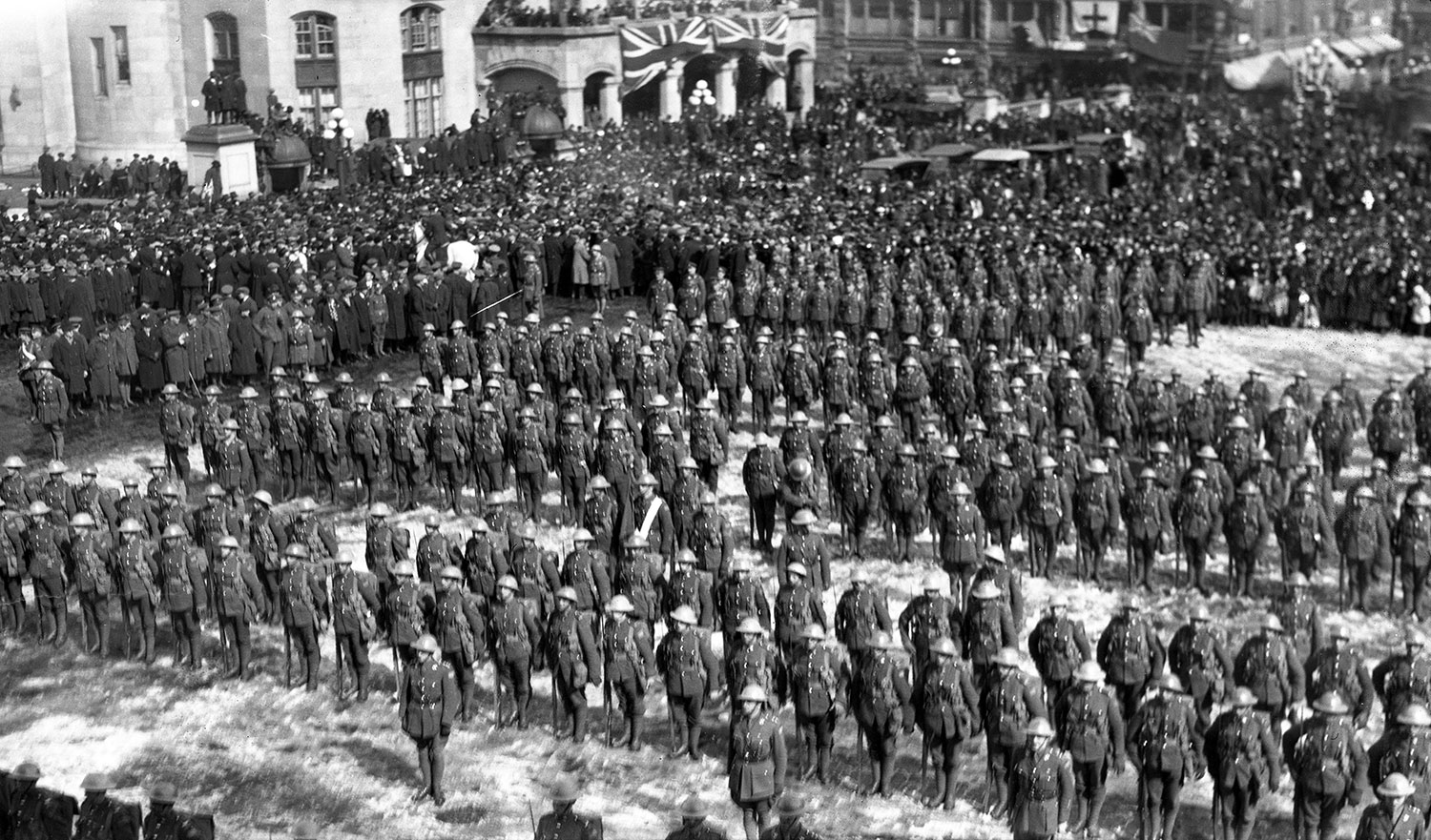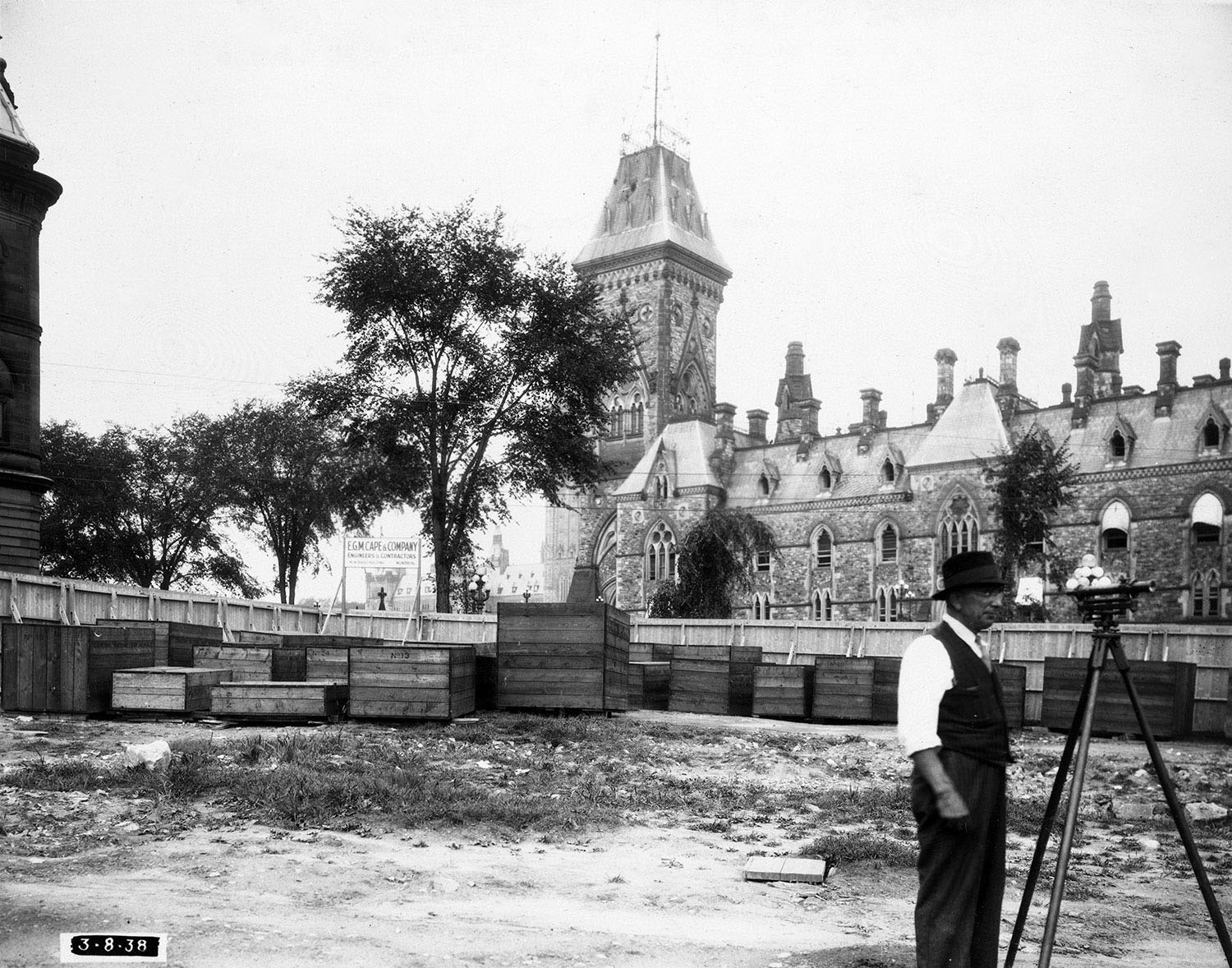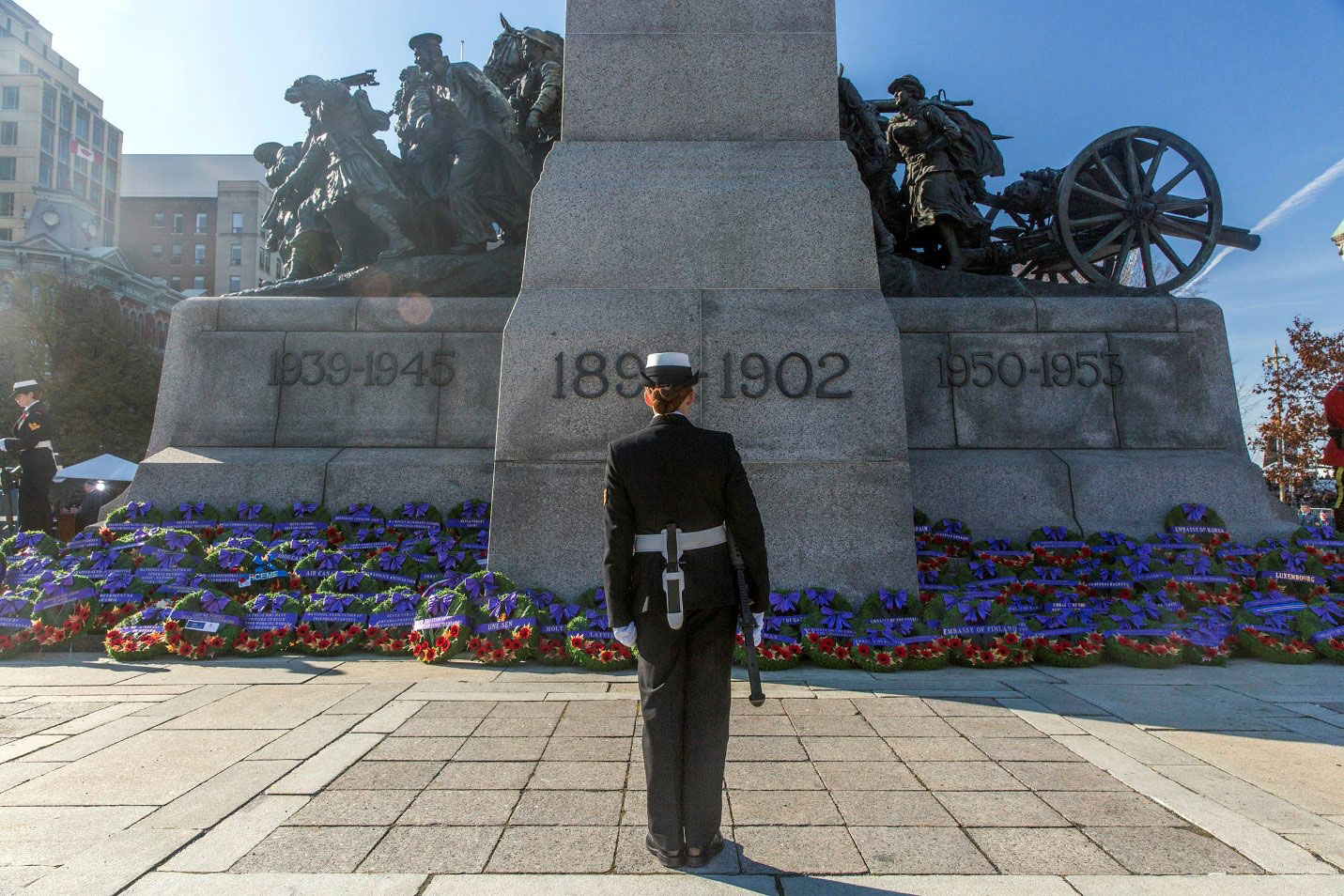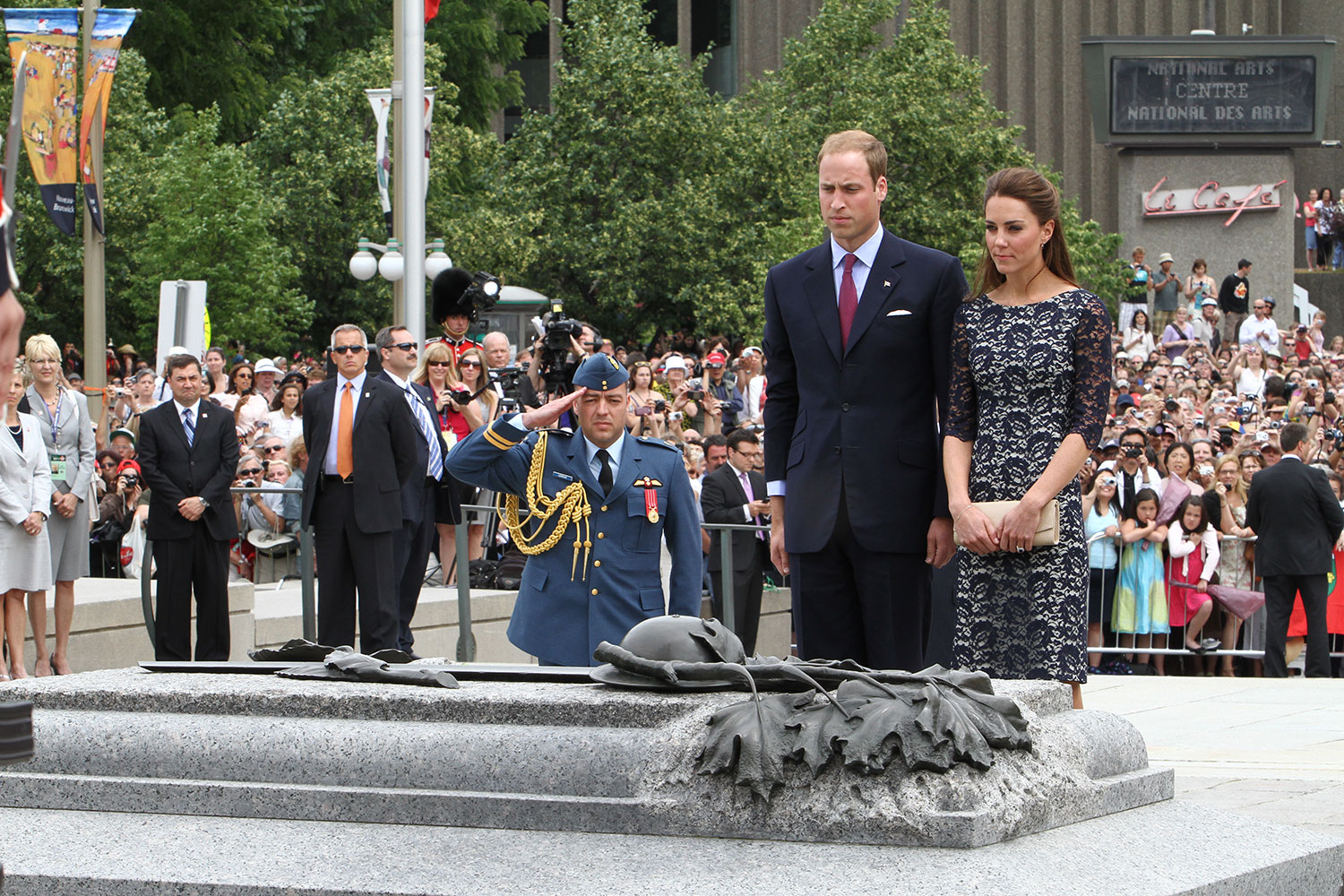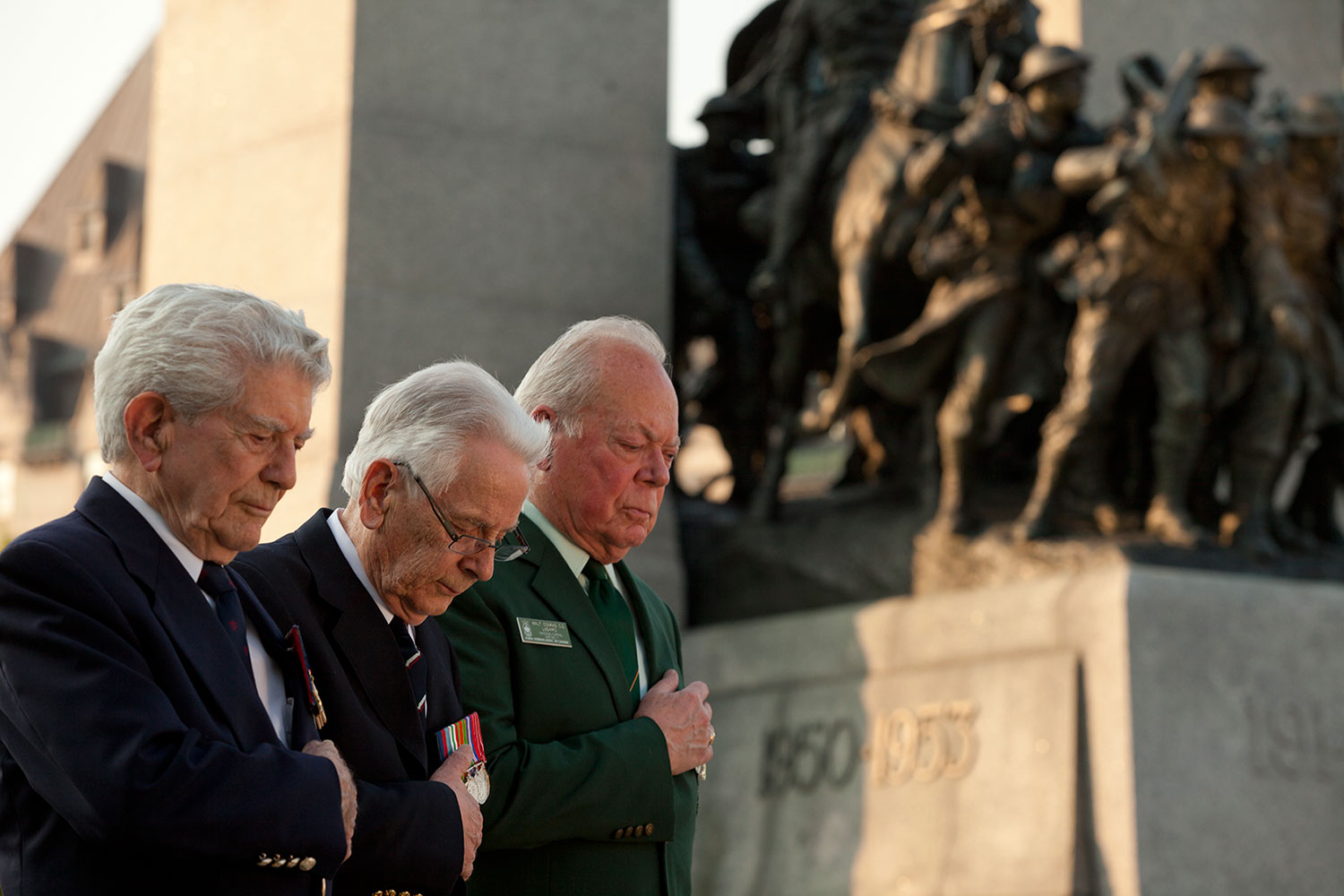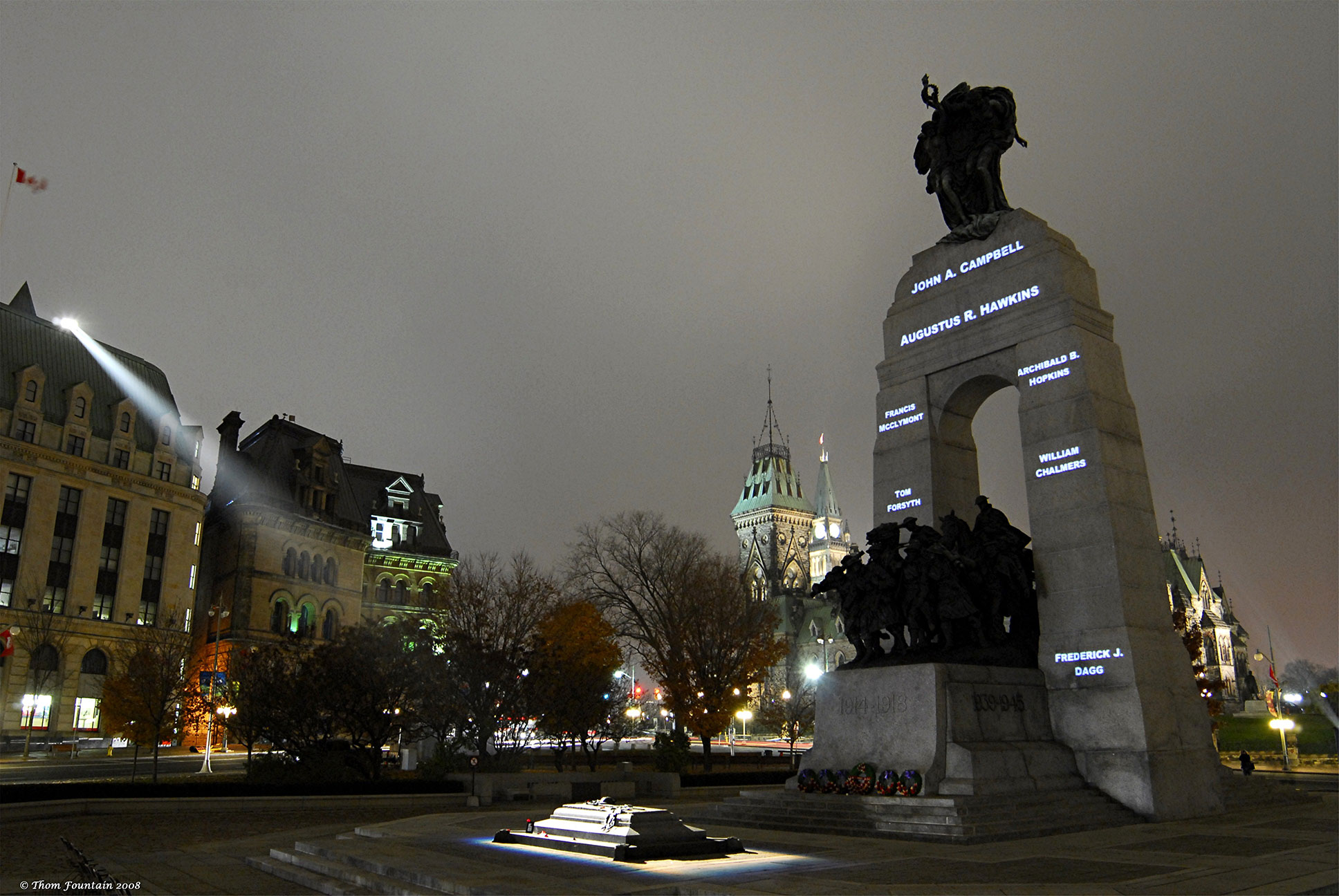Canadian Heritage exhibit
While the National War Memorial was being restored, Canadian Heritage installed an exhibit on the construction panels surrounding the Memorial. This collection of photograghs was on display from June to October 2016. Some of the text and images from the exhibit are below.
National War Memorial
Symbol of Remembrance
On May 21, 1939, King George VI unveiled the National War Memorial. Intended to honour those who fought in the First World War (1914 to 1918), it was called “The Response”, to symbolize Canadians' willingness to serve not just Canada, but the larger Empire (now the Commonwealth) to which it belonged.
Just months after the unveiling, Canada had entered the Second World War. The Memorial was rededicated in 1982 to honour those who had served in the Second World War and the Korean War. In 2000, Canada's Tomb of the Unknown Soldier was placed at the foot of the Memorial. To honour those who had participated in the South African War and the mission in Afghanistan, the Memorial was dedicated once again on November 11, 2014.
Over time, the Memorial has evolved into more than an iconic site. It is now a formal place of commemoration and remembrance where visiting dignitaries can pay their respects and all Canadians can mark November 11. It is also an informal gathering place where people can remember those who have served and sacrificed for their nation. The National War Memorial has transformed the heart of Canada's capital.
Honouring Sacrifice
The First World War touched almost every Canadian family. Some 650,000 Canadians served in that war, and 68,000 died. When the troops returned—including these members of the Princess Patricia's Canadian Light Infantry, Canadians wanted to honour their sacrifice. The need for a national war memorial was clear.
The Prime Minister's Choice

Prime Minister William Lyon Mackenzie King
Photo: Library and Archives Canada, PA-127563
(Click to view enlarged image)
Prime Minister William Lyon Mackenzie King, shown at Remembrance Day ceremonies on Parliament Hill in 1937, campaigned forcefully for a war memorial to honour the sacrifices Canadians made during the First World War. He also selected the site where the Memorial would be built.
International Competition
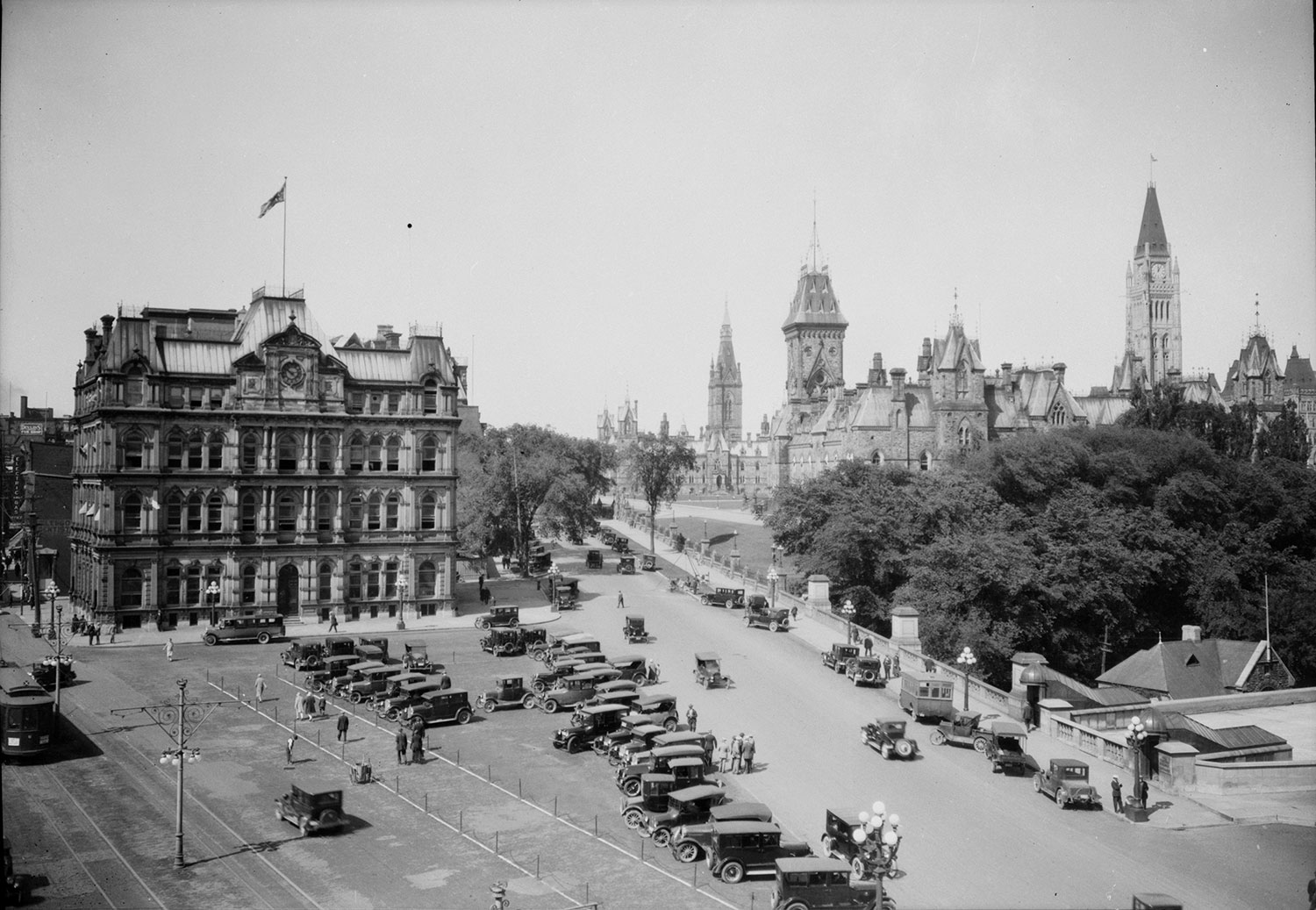
International Competition
Photo: Library and Archives Canada, PA-034370
(Click to view enlarged image)
In 1925, an international competition to design the National War Memorial attracted 127 submissions from Canada and abroad. Competition documents included photographs like this one of Connaught Place, the proposed location, now called Confederation Square. The post office, which originally dominated the site, was demolished and rebuilt, making space for the Memorial.
“The Response”, Peace and Freedom

"The Response", Peace and Freedom
Photo: The Ley and Lois Smith War Memory and Popular Culture Research Collection, Western University, London, Ontario
(Click to view enlarged image)
British sculptor Vernon March won the international competition to create the National War Memorial. Here, he works on the figures of Peace and Freedom. March's design captures the response of Canadians called to war. Whereas most war memorials glorify “victory,” this one emphasizes the willingness of Canadians to fight for peace.
A Capital Landmark

A Capital Landmark
Photo: Library and Archives Canada, e010900588 and e010900589
(Click to view enlarged image)
Construction of the Memorial finished in October 1938, but tree-planting and landscaping took another six months. This 1938 panorama shows how the site, where Wellington, Rideau and Elgin streets converge, dominates the capital's new urban design. At the centre of the image is the new post office, under construction.
Family of Artists

Family of Artists
Photo: City of Vancouver Archives, AM54-S4-: Mon P41.1
(Click to view enlarged image)
The completed bronze sculptures stand outside the March studio in England. Vernon March came from a working-class Yorkshire family but, remarkably, six of his brothers and one sister were artists. When Vernon March died suddenly in 1930, his siblings rallied around. They finished the figures in their own foundry.
Work Begins
The Ottawa site was not ready when the March family completed the sculptures in 1932, so they were exhibited for six months in Hyde Park, London, England, before going into storage. In 1937, the figures were shipped to Ottawa in wooden crates. Work began with Sydney March surveying the site and directing construction.
All of Us
These figures, laid out on the ground before being incorporated in the Memorial's granite arch, symbolize the “going forth of the people.” Capturing the diversity of the Canadian response, the 22 figures represent infantry, cavalry, riflemen, gunners, pilots, sailors, nursing sisters and lumbermen.
In the Presence of Royalty
Sunday, May 21, 1939, saw 100,000 eager Canadians, straining for a glimpse of King George VI and Queen Elizabeth, gathered in spring sunshine for the National War Memorial's dedication. The King described the Memorial as symbolizing a great truth: "Without freedom there can be no enduring peace, and without peace no enduring freedom."
Birthplace of New Traditions
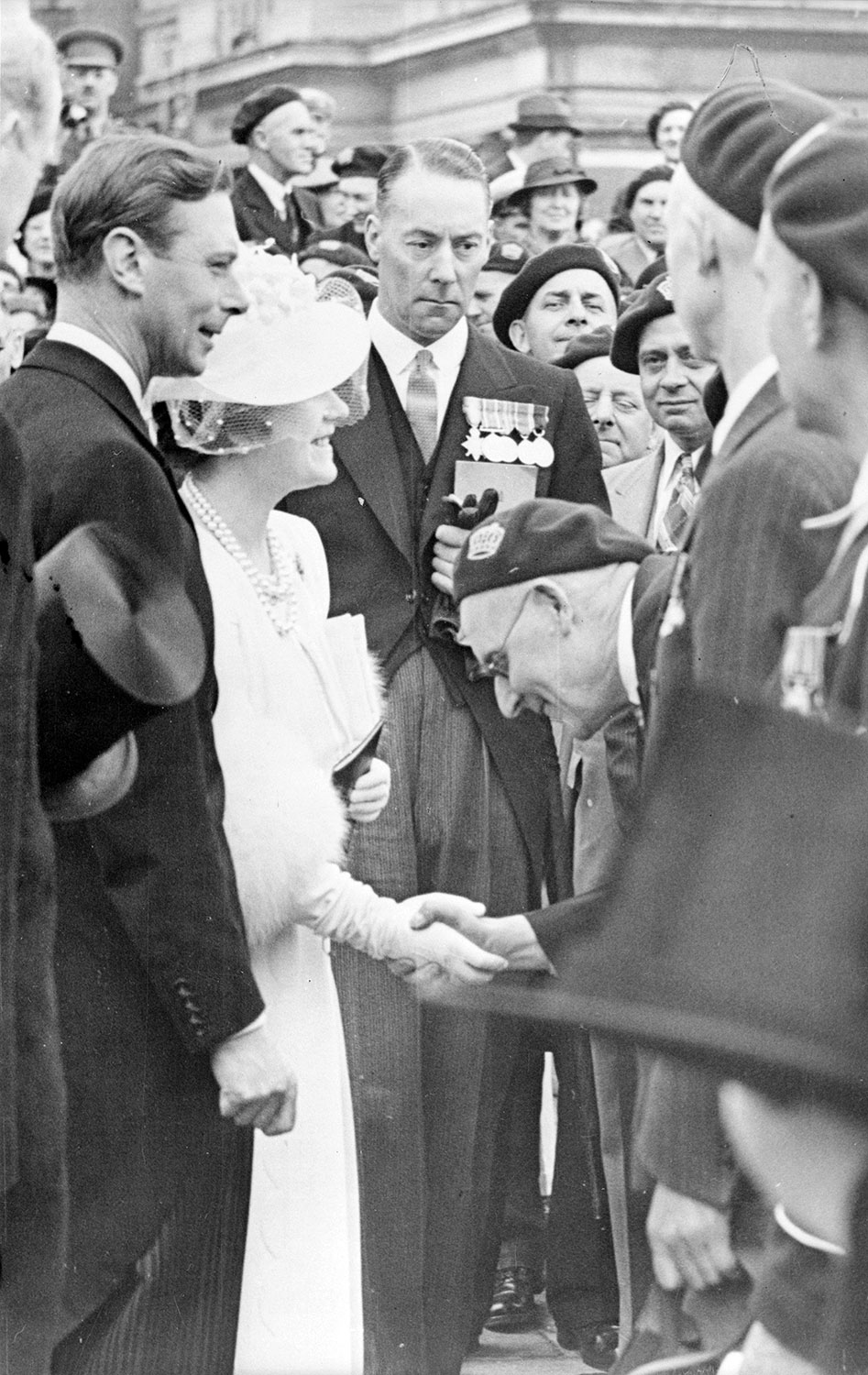
Birthplace of New Traditions
Photo: Library and Archives Canada, PA-211006
(Click to view enlarged image)
Following the 1939 dedication of the Memorial, King George VI and Queen Elizabeth broke with tradition to mingle with the crowd. Never before had a monarch reached out to talk so informally with the public; today, the “walkabout” is a royal tradition.
A Mother Remembers
Mrs. Catherine Lewis, who had lost two sons in the First World War, attended the 1939 unveiling. She was a recipient of Canada's Memorial Cross, known as the Silver Cross, which was instituted in 1919 and honours mothers whose children have died in war. A Silver Cross Mother now places a wreath at the Memorial as part of the national Remembrance Day ceremony.
Rededication
Just months after the Memorial's May 1939 unveiling, Canada was again at war. In 1982, Canada rededicated the National War Memorial to commemorate all Canadians who have served in war. The dates of the Second World War (1939 to 1945), unveiled here by Governor General Edward Schreyer (right), and the Korean War (1950 to 1953) were added to the granite plinth.
2014 Rededication
Canada rededicated the National War Memorial during the national Remembrance Day ceremony in 2014. The dates of the South African War (1899 to 1902) and the mission in Afghanistan (2001 to 2014) were added to the granite plinth, along with the phrase, “In Service to Canada.”
Remembrance Shared
Remembrance is not confined to Remembrance Day. Throughout the year, visiting dignitaries come to commemorate wartime alliances and anniversaries. The Duke and Duchess of Cambridge, Prince William and Catherine Middleton, came to pay their respects in June 2011, on their first official visit to Canada.
Honouring Canada's Veterans
Acts of remembrance honour not only those who have given their lives, but all those who have served. During the annual Remembrance Day ceremony at the National War Memorial, Canada pays tribute to all its veterans. The Memorial has also become an important site for veterans to reflect on their personal experiences.
Remembering in New Ways
Canadians continue to experience the National War Memorial in new ways. In the week leading up to Remembrance Day 2008, actor R.H. Thomson and lighting designer Martin Conboy orchestrated a unique commemoration, with the names of the 68,000 Canadians who died in the First World War being projected on the Memorial's granite walls.
- Date modified:
